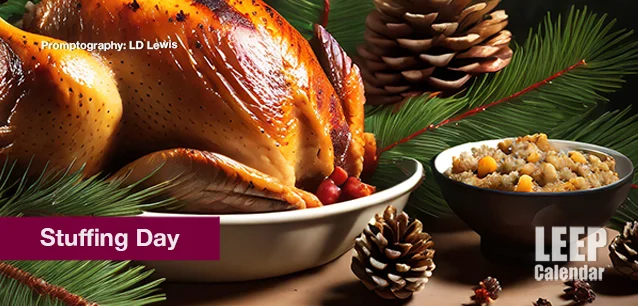 AD
AD
Today is: December 17
Scroll to explore events active on this date.
Additional Events on LEEP
LEEP INK FEATURES

August? Absolutely!
In August, we live through the Dog Days of Summer. It's hot and often humid, and those who can leave for better climates do. Down south, winter is in full force. August is also known as "the ...

In The Heat of July: July 2025 Events
Is it hot enough (or cold enough if you're below the equator) for you yet? There is actually a day for that! Like every month, I pick a diverse collection of events you may or may not know about. This ...

May Blooms: Events in May 2025
Along with October, May is one of the most densely packed months of the year. It's before the summer humidity and the last whole month of the school year. The weather is warming in t...
About Stuffing Day
Ends: Nov 21, 2023
DESCRIPTION:
Stuffing, a staple at Thanksgiving feasts in the United States, has a rich history that dates back centuries, long before the holiday became an American tradition. This savory dish, typically made with a mixture of bread, herbs, and various other ingredients, has evolved, reflecting the tastes and traditions of different cultures and regions.
Stuffing birds for cooking originated during the Roman Empire, as documented in the ancient cookbook "Apicius." This collection of Roman cookery recipes includes methods for stuffing chicken, rabbit, pork, and other meats with various ingredients, such as vegetables, herbs, spices, nuts, and grains.
The concept of stuffing traveled through Europe and was well-established when the Pilgrims and other settlers arrived in North America. While it's unclear whether stuffing was part of the first Thanksgiving feast shared by the Pilgrims and the Wampanoag tribe in 1621, some form of stuffing was likely known to and prepared by the early settlers, given its prevalence in European cooking.
In the United States, stuffing recipes began to appear in cookbooks in the 18th century, reflecting regional influences and available ingredients. For example, in the South, cornbread stuffing became popular, while in the North, bread, apples, onions, and herbs were commonly used in other regions.
The term "stuffing" itself has varied across regions and periods. In England, it was traditionally called "forcemeat" or "farce," and in parts of the United States, it is often referred to as "dressing." The method of preparation also varies, with some choosing to cook it inside the bird (hence "stuffing"), while others cook it as a separate dish (often referred to as "dressing").
The 19th and 20th centuries saw the commercialization and simplification of stuffing by introducing pre-made mixes. These convenient products, such as the iconic Stove Top stuffing introduced in the 1970s, became popular in American households, especially for busy cooks preparing large Thanksgiving meals.
Today, stuffing is a Thanksgiving essential, with recipes passed down through generations and new variations continually created. From traditional bread-based stuffings to gluten-free or vegan alternatives, the dish exemplifies the holiday's spirit of abundance, tradition, and creativity.
VIDEOS
SUPPORTING DOCUMENTS
Currently, this event does not have supporting documents.
ADDITIONAL IMAGES
Currently, this event does not have supporting images.
Where would you like to go now?
 AD
AD


/footer-logo.svg)
